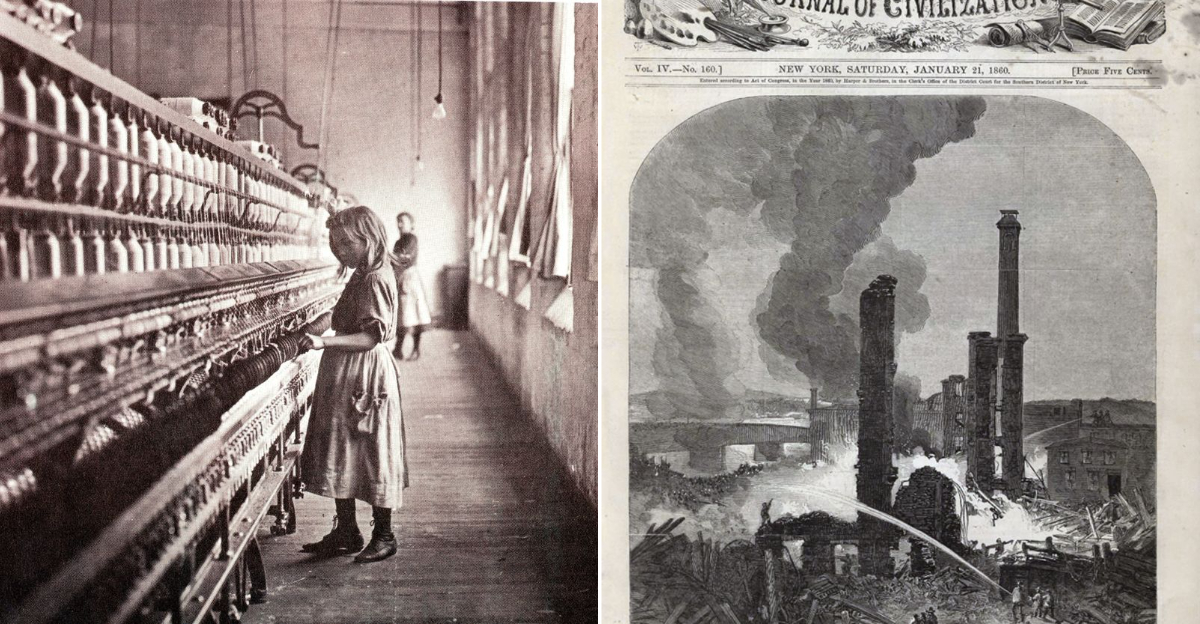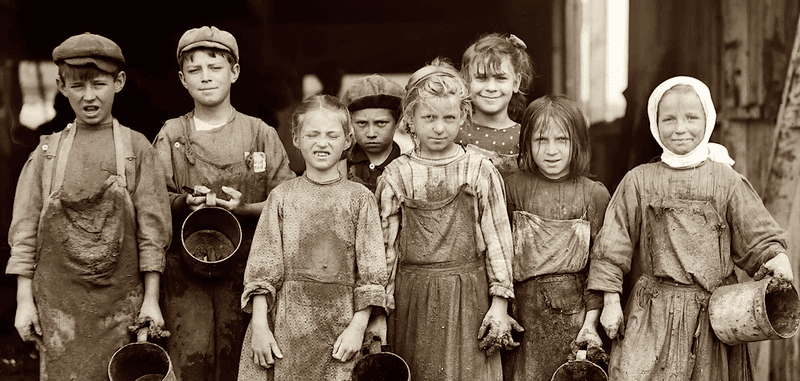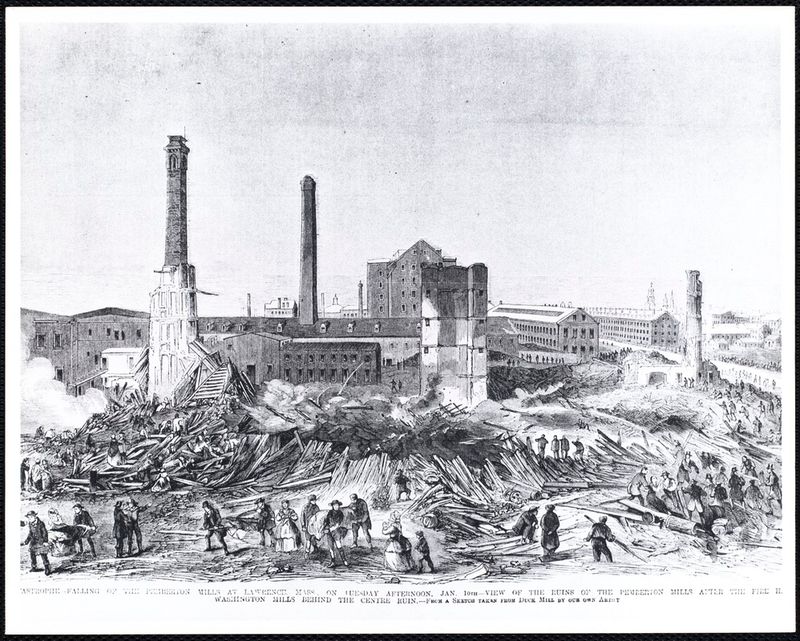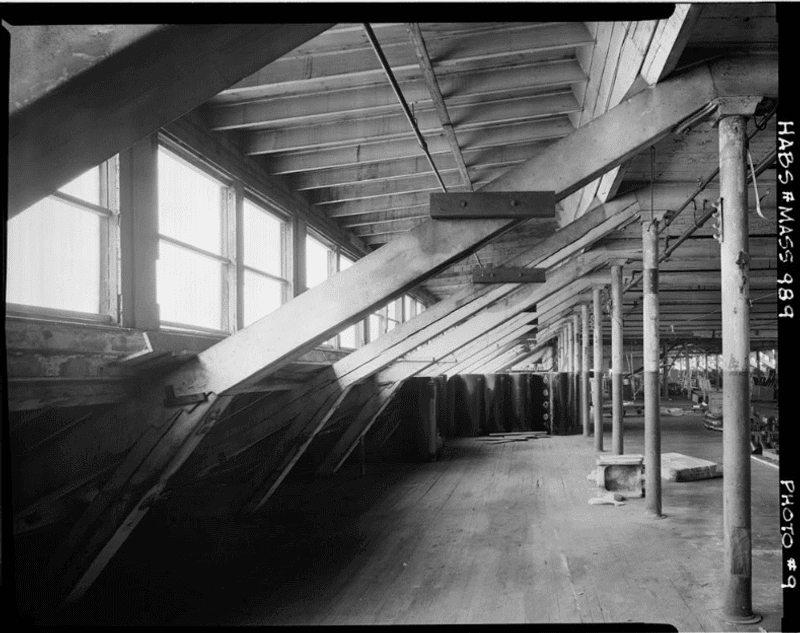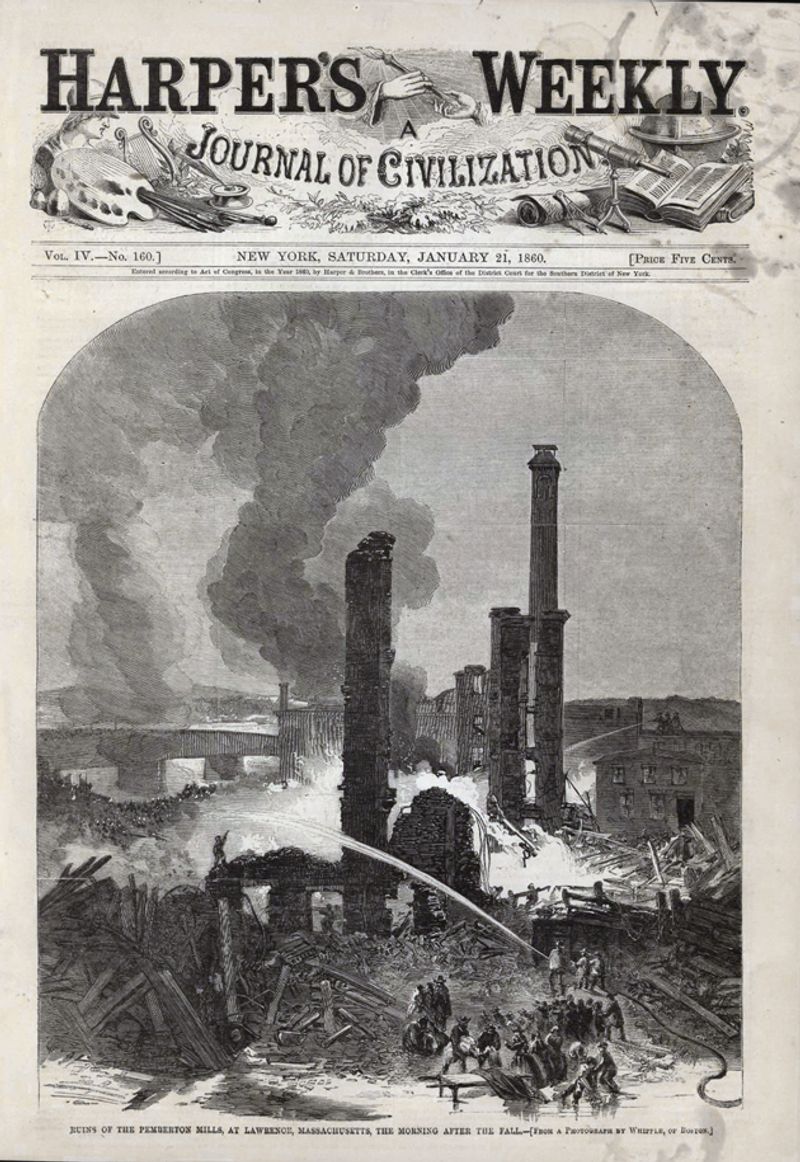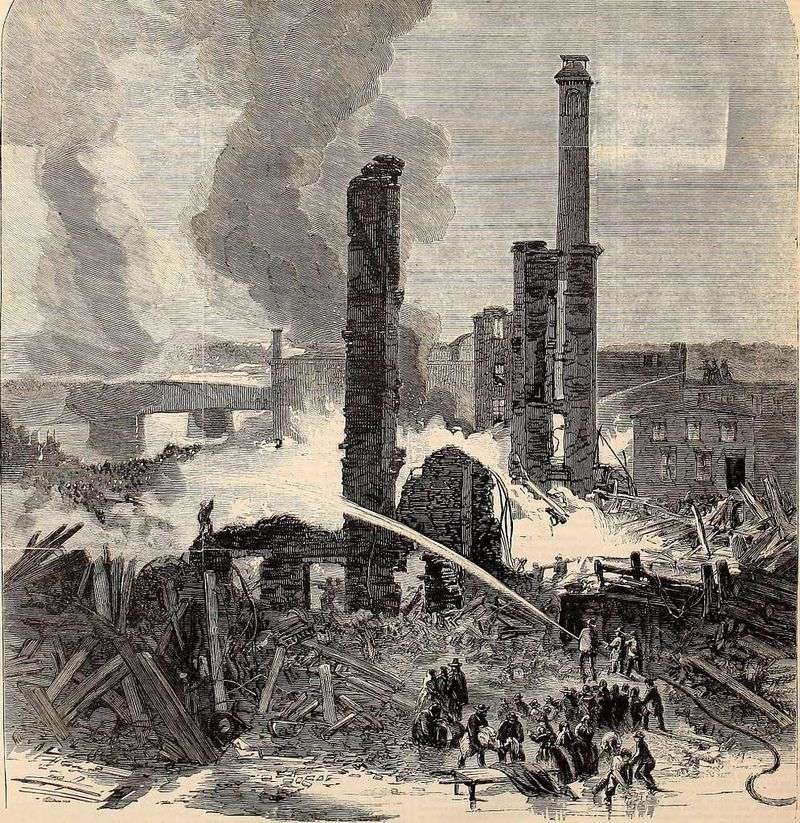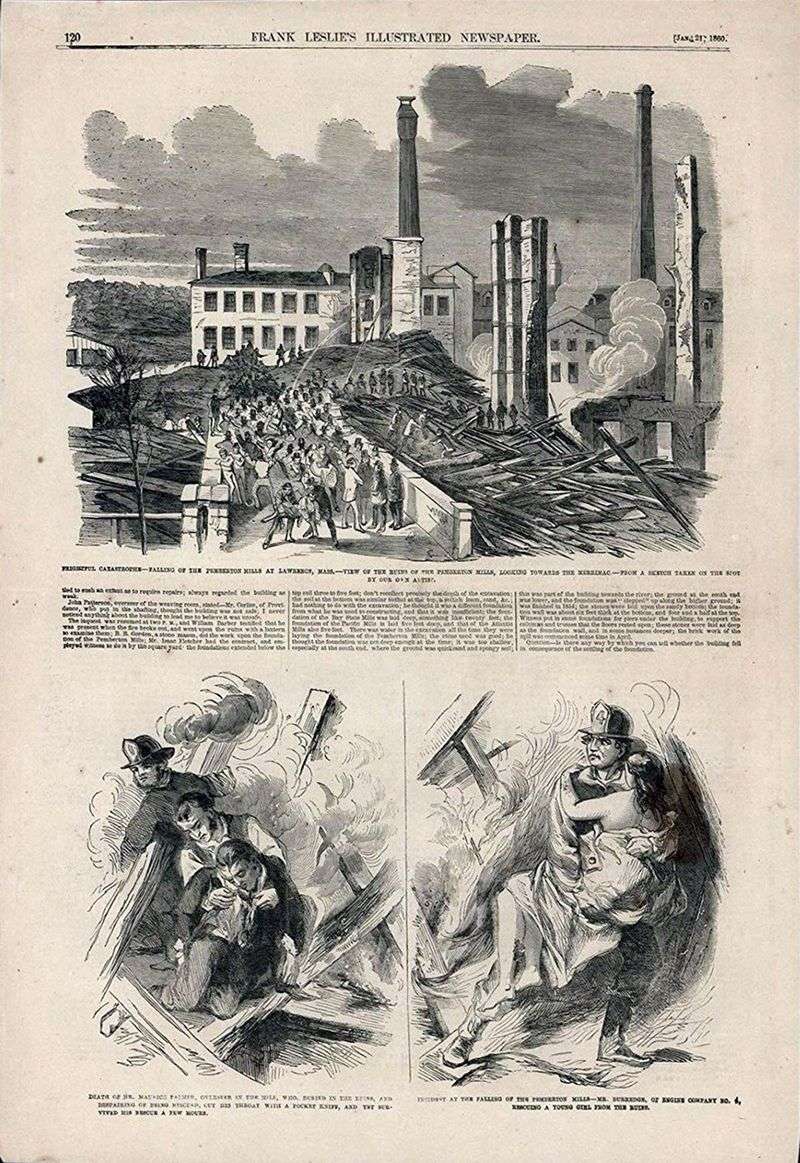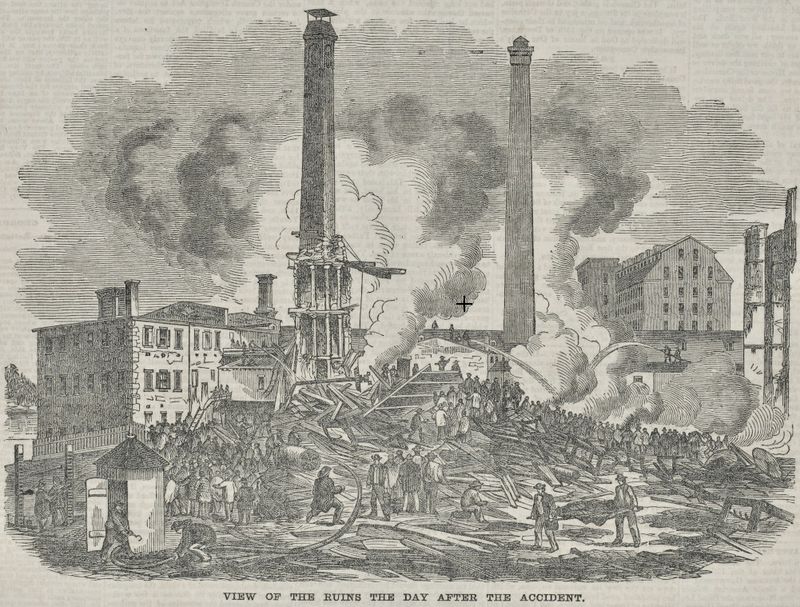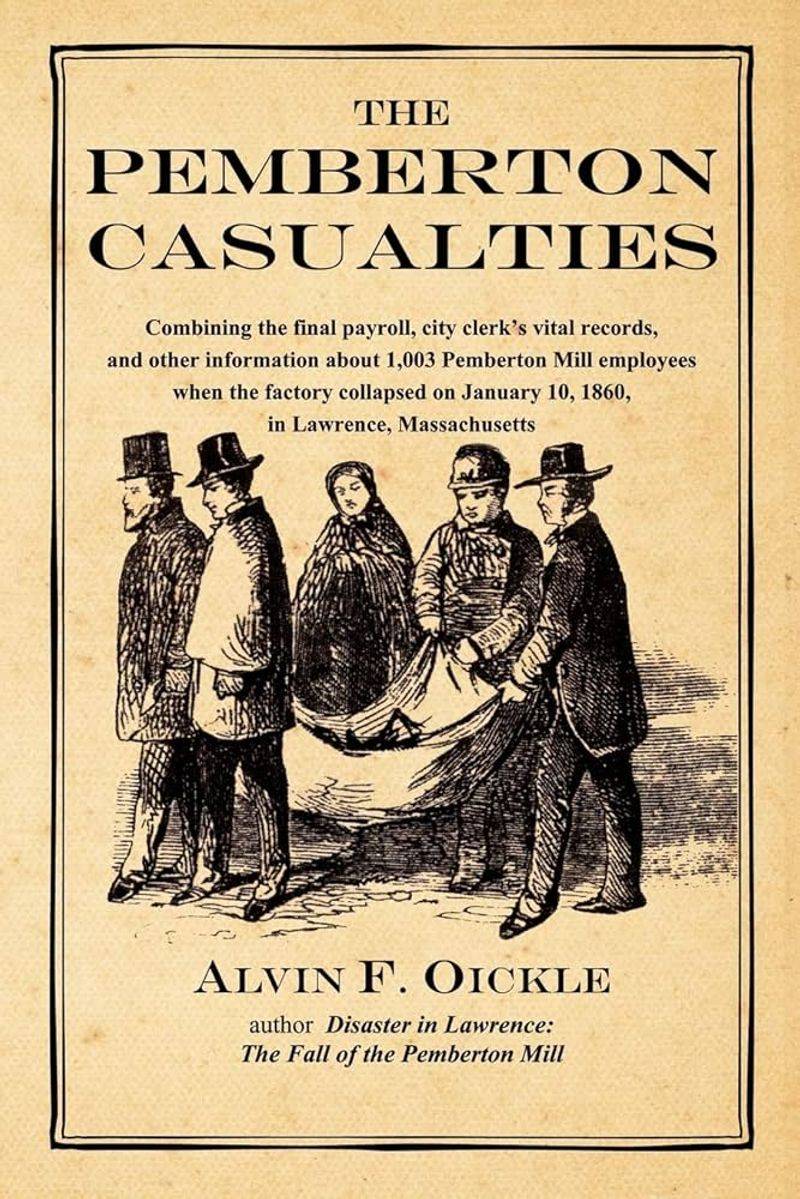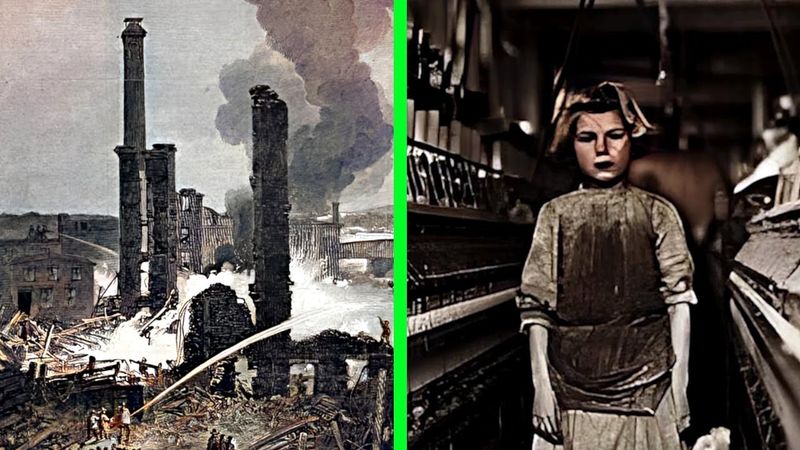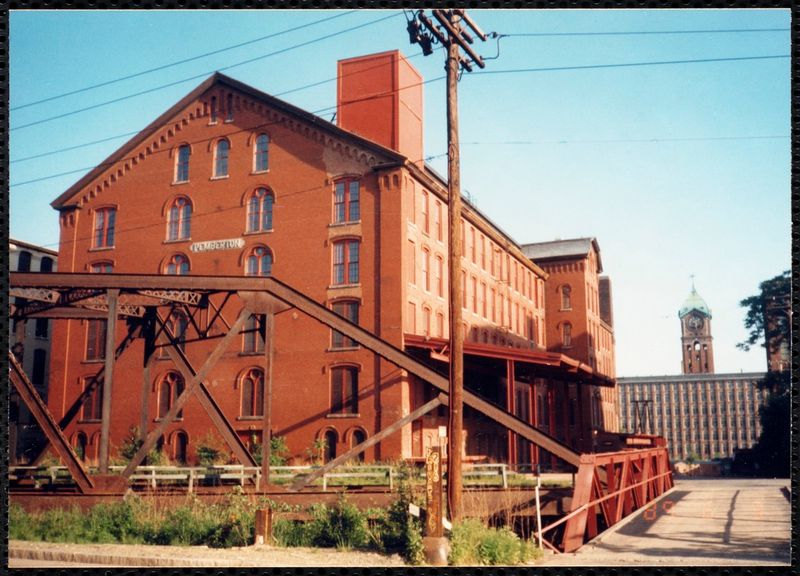On the cold evening of January 10, 1860, the Pemberton Mill in Lawrence, Massachusetts, collapsed without warning—burying hundreds of workers under brick, steel, and flaming rubble. In just 90 seconds, 145 people—mostly immigrant women and children—were killed in one of the deadliest industrial disasters in American history. More than a century and a half later, the tragedy remains a chilling example of greed, negligence, and the high human cost of industrial ambition. Here are the 14 key moments that explain why the Pemberton Mill disaster changed everything.
1. The Pemberton Mill Was Hailed as a Marvel—But Built on Cheap Steel
The Pemberton Mill, opened in 1853, was celebrated for its remarkable speed and output. However, lurking beneath the applause was a critical flaw: flimsy cast iron beams. Engineers quickly identified the structural weakness, but profit-driven motives overshadowed urgent safety concerns. The mill’s grandeur masked a perilous reality. This negligence set the stage for a catastrophic collapse, highlighting the era’s industrial priorities at the expense of human safety. Such oversight in construction would ultimately lead to one of the deadliest industrial disasters in history. It was a tragic reminder that appearances can be dangerously deceiving.
2. Hundreds Worked in Tight Quarters—Many Were Children
Over 600 workers, mainly immigrants from Ireland, Scotland, and Germany, filled the Pemberton Mill’s cramped spaces. The workforce included numerous children, some as young as eight, laboring long hours for meager wages. These vulnerable workers faced grueling conditions, reflecting the era’s disregard for worker welfare. The oppressive environment fostered both physical and emotional strain. Despite the harshness, the promise of employment drew families seeking a better life. Yet, the mill’s collapse shattered those dreams, underscoring the dire realities of industrial ambition. Such stories reveal the human faces behind historical tragedies.
3. It Took Just 90 Seconds for the Entire Structure to Crumble
In a mere 90 seconds, the Pemberton Mill crumbled, leaving behind a chaotic landscape of destruction. As floors pancaked one after another, machinery plummeted, creating a deafening roar likened to thunder. Survivors described the moment as surreal, with disbelief etched on their faces. The rapid collapse offered no time for escape, trapping hundreds under tons of rubble. This brief, devastating event was a grim testament to the mill’s inherent design flaws. Such a swift downfall left a lasting impact on industrial safety standards, serving as a cautionary tale for future architectural endeavors.
4. The Walls Didn’t Just Fall—They Trapped the Living
When the Pemberton Mill’s floors gave way, the outer walls followed suit, collapsing inward and sealing the fate of many trapped inside. Escape routes were abruptly blocked by immense beams and bricks, imprisoning hundreds in an inescapable nightmare. Those caught beneath the rubble faced an agonizing wait for rescue. The walls, intended to provide shelter, instead became instruments of entrapment. This tragic turn of events highlighted the mill’s catastrophic design flaws, leaving a lasting impression on industrial history. It was a harrowing reminder of the dire consequences of ignoring structural integrity.
5. A Survivor’s Quote: “The Earth Opened and Swallowed Us”
Survivors of the Pemberton Mill disaster shared haunting accounts in the aftermath. One chilling quote described the collapse as if the building “shook itself to pieces.” The earth seemed to open up, consuming all within. These vivid recollections painted a picture of chaos and despair. Screams echoed through the darkness, emphasizing the terror experienced by those trapped. Such personal narratives added depth to historical understanding, humanizing the tragedy beyond mere statistics. The power of survivor testimony ensured that the events of that fateful day would not be forgotten, etching them into collective memory.
6. Rescuers Had No Idea What They Were Walking Into
First responders, many of whom were townspeople with personal connections to the trapped, faced an overwhelming scene of devastation at the Pemberton Mill. With no formal training or equipment, they navigated through debris, pulling survivors out by hand. The chaotic rescue efforts were marked by desperation and determination. The unpreparedness for such a disaster underscored the need for organized emergency response systems. Despite the carnage, the bravery and selflessness of these everyday heroes became an enduring symbol of community resilience in the face of unimaginable adversity.
7. Then the Fire Started
As if the collapse wasn’t enough, a new horror emerged: fire. Lanterns and leaking gas ignited the wreckage, transforming the scene into a fiery inferno. Flames roared through the debris, claiming countless lives already weakened by the collapse. This secondary disaster compounded the tragedy, leaving rescuers and survivors alike in despair. The fire’s intensity highlighted the dangers of industrial environments, where even a spark could lead to catastrophe. Such horrors underscored the urgent need for safety regulations, reminding future generations of the risks inherent in unchecked industrial growth.
8. Screams Could Be Heard Beneath the Flames
Amidst the chaos, eyewitnesses recounted hearing cries for help from beneath the roaring flames. Trapped under beams, fully conscious, victims’ voices pierced the smoke-filled air. As the fire spread, the panic intensified, but hope faded with each passing moment. These heart-wrenching cries resonated with rescuers, fueling their frantic efforts. The haunting sounds served as a chilling reminder of human suffering in the face of disaster. Even as silence eventually prevailed, the echoes of those trapped souls lingered, a testament to the enduring impact of one of America’s deadliest industrial tragedies.
9. Makeshift Morgues Were Set Up in Nearby Buildings
In the aftermath of the Pemberton Mill disaster, makeshift morgues were hastily established in nearby buildings, including schools, churches, and stores. Bodies, many burned beyond recognition, were brought for identification. Grieving families searched for loved ones amid the somber surroundings. The scale of the tragedy overwhelmed local resources, necessitating these temporary solutions. Entire families were lost, leaving a profound mark on the community. This grim process highlighted the human cost of industrial ambition, serving as a stark reminder of the need for stringent safety protocols to prevent future tragedies.
10. Blame Came Quickly—But Justice Never Did
Following the disaster, investigations revealed that builders had ignored clear warnings about the mill’s structural instability. An engineer described the building as “unsafe from the start,” yet no legal action was taken against those responsible. The lack of accountability left victims’ families without closure. Public outcry demanded justice, but it remained elusive. This failure to address negligence highlighted systemic issues within industrial practices of the time. The absence of liability served as a lesson in the importance of enforcing safety regulations, ensuring that profit never outweighs human lives.
11. Newspapers Across the U.S. Demanded Reform
The Pemberton Mill disaster captured national attention, with newspapers across the United States demanding reform. Editorials condemned the lack of safety regulations in factories, urging immediate changes to protect workers. Public outrage fueled discussions on industrial accountability and the necessity of oversight. The media’s role in amplifying these concerns marked a turning point in labor rights advocacy. This widespread call for reform underscored the growing awareness of the human cost of industrial progress, paving the way for future legislative action. The press’s influence proved pivotal in shaping public discourse.
12. Massachusetts Began Pushing for Building Codes
In the wake of the Pemberton Mill disaster, Massachusetts began discussions around implementing building codes. The tragedy highlighted the urgent need for mandatory inspections and standardized materials to ensure structural integrity. Although slow-moving, these early efforts laid the groundwork for modern building regulations. The state’s proactive approach reflected a shift in priorities towards prioritizing safety over profit. This initiative served as a beacon of hope for preventing future catastrophes, demonstrating the power of legislative action in safeguarding public welfare. Such measures became a crucial component in the evolution of industrial safety standards.
13. The Disaster Became a Rallying Cry for Labor Rights
The Pemberton Mill disaster emerged as a powerful symbol in the fight for labor rights. Unions and reformers pointed to the tragedy as evidence of the dangers posed by unchecked capitalism. It became a rallying cry in pamphlets, speeches, and rallies, galvanizing support for worker protection. The disaster’s impact extended beyond immediate reforms, influencing labor movements for decades to come. This pivotal moment illustrated the potential for collective action to drive change, inspiring generations to demand safer working conditions. The legacy of Pemberton Mill resonated within the broader narrative of labor history.
14. A Plaque Remains—But Few Remember
Today, a modest plaque in Lawrence commemorates the Pemberton Mill disaster, yet its memory has largely faded from public consciousness. Unlike more famous tragedies, this disaster remains obscure despite its significant historical impact. The plaque stands as a testament to the lives lost and lessons learned, urging reflection on the cost of progress. Its quiet presence serves as a reminder of the need to remember past mistakes to prevent future ones. While the mill itself no longer stands, its story endures through this humble marker, inviting passersby to consider the human stories woven into history’s fabric.
